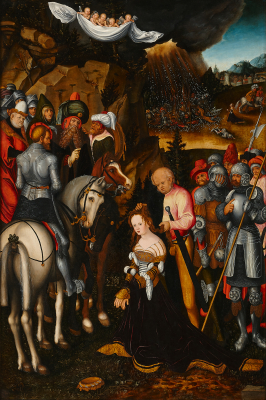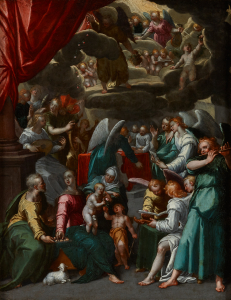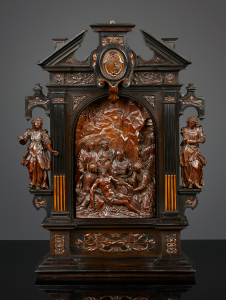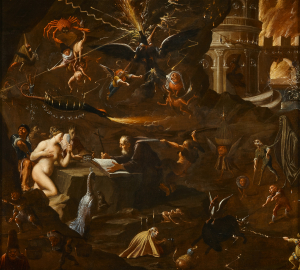Elias Hauptner (ca. 1575-1627), after Lucas Cranach
Elias Hauptner (ca. 1575-1627), after Lucas Cranach
This painting depicts various episodes from the life of Saint Catherine of Alexandria, one of the most popular saints in the Middle Ages. As one of the Fourteen Holy Helpers, she was invoked as a protector against the plague and a guardian of chastity. She was also sometimes considered a guardian of safe childbirth.
Catherine came from Alexandria, and was so devoted to Christ that she pledged her virginity to him. Shortly after this promise, Emperor Maxentius fell in love with her, but she rebuffed his advances in order to keep her vow. The emperor then sent forty pagan philosophers to convert Catherine, but instead of being swayed to pagan ways, Catherine converted them all to Christianity. The emperor then sought to have her tortured on a spiked breaking wheel, but the wheel was destroyed by lightning; this event is shown in the background of the painting. The emperor’s next gambit was to have Catherine burned, but the fire burned the executioners instead. Finally, Maxentius ordered Catherine’s decapitation. This attempt was successful; however, what flowed from the wound was not blood, but milk that saved the city from the plague.
Catherine’s body was carried to Mount Sinai by angels, where it was discovered by pilgrims in the year 800, nearly five hundred years later, still in perfect condition. St. Catherine’s Monastery was built next to the mountain.
At first glance, this appears to be a handsome piece by Lucas Cranach the Elder (1472-1553). However, closer inspection reveals that it is a signed and dated work by the hand of Elias Hauptner. The signature reads as follows: Elias haupner in olmicz 1623.
This piece is an exceptionally fine copy of the painting of the beheading of Saint Catherine that Cranach produced in 1515 for a church in Olomouc (German: Olmütz) at the commission of Stanislaus Thurzo. The latter is now housed in the archiepiscopal palace in Kroměříž along with a pendant depicting the beheading of John the Baptist. Cranach considered the 1515 commission prestigious enough to insert himself into the John the Baptist painting as one of the soldiers.
Elias Hauptner
Elias Hauptner was a painter in Olomouc in the early seventeenth century, whose name has fallen into obscurity over the centuries. When signed paintings by his hand were discovered, the dating was unfortunately misread. As a result, he was for many decades considered an eighteenth-century painter, which had a significant negative impact on the appreciation of his works.
However, recent research has returned Hauptner to his correct place in history and restored his esteem: he was in fact an important figure in early seventeenth-century Moravian painting, and one of the few painters active in the region around that time that we still know of today. Four works on copper by his hand survive; they were made for Olomouc’s cathedral, where they still are kept today. The fact that these works can still be admired in their original location after all these centuries is remarkable.
What do we know about this painter? The exact spelling of his name varies, but within the usual limits. We choose to observe the established and customary German version used in sources – Elias Hauptner – although his estate inventory notes the name “Haubtner”, and the variant “Heipner” is also known. In 1609 he was recorded as “Haupner” when he purchased a home in Olomouc.
Hauptner originally came from Šenov (also Schönau or Szonów), near the town of Nový Jičín; this is sometimes reflected in his signature E.H.V.S. on woodcuts for books that he illustrated. Born in Šenov around 1575, he spent his youth in the painting workshop of Melchior Koch in Nový Jičín before continuing his studies in Opava. This is likely where he became acquainted with Opava’s governor, Albrecht Sedlnický of Choltice, and entered his service as a painter. He is recorded as such on 12 May 1602, when he married Kateřina Karasová, from Opole, in Opava’s Church of St Jiří. In 1607 he moved to Olomouc, where he purchased a home from Michael Leuchsprenkel for 500 zloty on 17 September 1609, as “Elias Haupner, Maler”. However, he soon sold it on and purchased another home nearby in 1613 with his wife, again reselling it shortly after, for the sum of 500 zloty. By this time he had entered his second marriage. In 1622, he was noted as a sworn-in member of the painter-goldsmith's guild.
Elias Hauptner died in early 1627, and his estate was inventoried on 25 February of that year. It was a substantial estate by the standards of painters in Olomouc: aside from various silver, tin and copper objects, it contained canvas, clothing and other household objects, painting supplies, example books, prints and paintings. A piece showing the beheading of Saint John the Baptist ("Ein Controfect Joanni enthabtung”) was valued at 12 zloty. This archival information reflects the personality of Elias Hauptner, who – following his apprenticeship in a Northern Moravian workshop – was likely not content with the opportunities in Nový Jičín, and managed to rise to the status of a painter in aristocratic circles.
In Opava, he was in the service of governor Albrecht Sedlnický of Choltice. Whether he was permanently or intermittently employed by Sedlnický during his time in Opava is unknown, but it seems he was not satisfied with his position in Opava, as he and his wife moved to the Moravian metropolis of Olomouc. We can only speculate as to the exact reasons for this move, but he may well have been attracted by the prospect of more lucrative projects. Faith may also have played a role; Albrecht Sedlnický was a devout Catholic, while Opava was a purely Protestant town. A number of the works that Hauptner produced during his time in Olomouc can be directly linked to the Catholic clergy, and his graphic works also suggest a Catholic orientation, so it is possible that commissions were too few and far between for him in Opava’s Protestant climate.
The two paintings by Lucas Cranach, which by the time that Hauptner moved to Olomouc had already adorned a church year for approximately one hundred years (and are now found in the archiepiscopal palace of Kroměříž), were highly appreciated. This is evident from the fact that in 1609 or 1619 – the date is difficult to read – Hauptner painted a copy of Cranach’s St John panel on copper for Vaclav Pilar, Canon of Olomouc since 1606, whose family crest is portrayed on that painting. This painting has been in the possession of the Angermuseum in Erfurt since the early twentieth century. Another client requested a copy of the St Catherine panel in 1623, though their identity remains unknown. According to a label on the painting’s reverse, the St Catharine panel was once the property of the noble Migazzi family from Hungary, whose ancestral castle stands in Zlaté Moravce. The Migazzis also resided in Vienna, where Christoph Anton Migazzi von Wallu und Sonennthurmu († 1803) held the position of archbishop.
Hauptner produced a large number of paintings for the church in Olomouc, and it is therefore likely that this is where he found his clients. The identity of the person who commissioned the St Catherine panel based on Cranach’s original in Olomouc must likely be sought in these circles as well.
The fact that this painting is a copy of a painting that predates it by a hundred years does not diminish its quality in any way. It should be viewed in the light of a time when Catholicism in Moravia was under pressure from the Reformation, as a result of which there was no room for a unique visual idiom, and interest in religious art declined. This painting of St Catherine was Hauptner’s attempt to preserve what little still remained.
As noted, this work is strongly reminiscent of Lucas Cranach’s original, so it is not surprising that it was auctioned as a Cranach by Charpentier in Paris in the 1950s. In an annotated auction catalogue preserved by the Netherlands Institute for Art History in The Hague, the great art connoisseur Frits Lugt even hand-wrote the word “Echt” (Dutch for “authentic”) next to it to confirm the piece’s authenticity. In short, the quality of this painting deserves to be described as exceptional.
- Provenance
- Count Migazzi, 18th - 19th century, as evidenced by a label on the reverse
Auctioned at Dorotheum in Vienna, 19 December 1943, lot 40 with illustration, as German dated ca. 1620
Private collection
Auctioned at Charpentier in Paris, 20 March 1953, lot D with illustration, as Lucas Cranach the Elder, with Gutachten by Leo van Puyvelde and annotation “goed” by Frits Lugt. (copy owned by Netherlands Institute for Art History).
Collection of Hans Schröder, Saarbrücken.
Private collection - Period
- 1623
- Material
- oil on panel
- Signature
- Elias haupner. in olmicz 1623
- Dimensions
- 96 x 64 cm
Global shipping available










